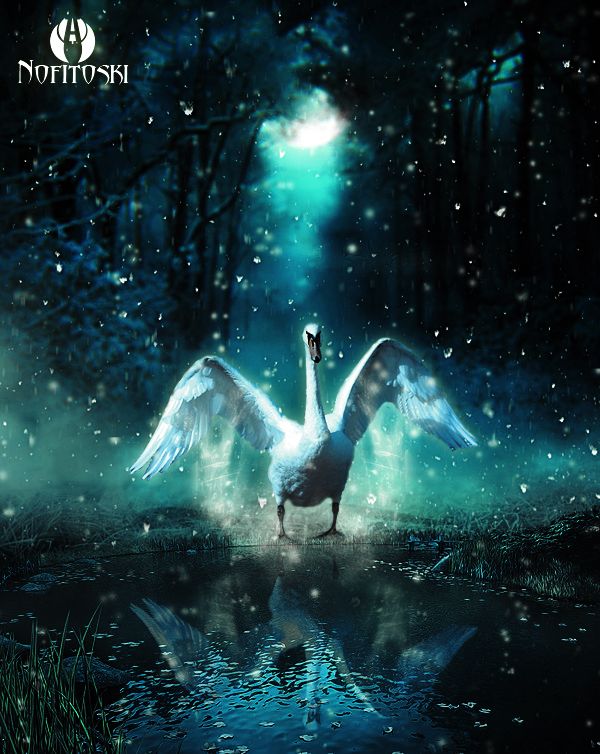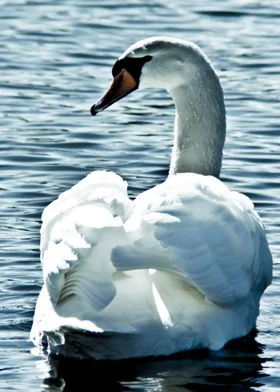Mythic Origins

The most commonly accepted origin story for the Swans comes from Celtic myth. Much to the angst of Lir who felt it should have been him, Bodb Derg was elected king of the Tuatha De' Danann, the Celtic pantheon. Trying to appease Lir and end the strife he was causing, King Bodb offered one of his daughters to Lir in marriage. This was enough to form and alliance and end the rebellion.
Lir's wife produced four children, but died shortly after the birth of the last. Lir was distraught but carried on for the love of his children. King Bodb then sent another daughter for Lir to marry who grew jealous of the affection Lir had for his children. When faking an illness for a year failed to earn his adoration, she set out with her stepchildren for a ride through the country, intent on killing them. But, her guards refused to slay them and she could not follow through herself. Instead, she took them to a lake and had them bathe. Once they were in the water, she cast a spell, turning them into four white swans.
When the Tuatha De' Danann learned of this, she was told to undo the spell or face the wrath of the gods. Rather than breaking it, she put a time limit upon it, in which the children would live as swans for 300 hundred years in three of the great lochs, for a total of 900 years thus cursed. She also allowed them to retain the power of speech, stating they would sing plaintive songs without equal, and would not be distressed by being in bird form.
Although their stepmother was cursed into the form of an air demon for the rest of eternity, their time as swans was not untroubled, experiencing great storms that froze them to one lake, one lake being filled in and depleted of waters, and once bound in silver chains by a monk who refused to return them to their family. They were finally free from swan form when King of Connacht attempted to take them from the monk. His touch upon the swan's feathers saw them withering away to leave three very old men and one very old woman in place, lean, frail, and bony, and close to the death that finally gave them release.
Leadership & Social Structure
Every generation a Swan King and Swan Queen are born, destined to be mates and rule together, each identified with a swan-shaped birthmark. Unlike many other leaders, the Swan King and Queen do not remain in one place, but rather travel the world to ensure that their kind are cared for.
While Swans recognize the authority held by this pair, each Bevy, or local group of Swans, is led by a Swan Prince and his mate. The Swan Prince is appointed by the Swan King and answerable to him.
For Swans in particular, to be part of a Bevy or not is a particularly difficult choice. Most opt to take advantage of a living together and pooling their resources, which allows them to ensure their dwelling and the surrounding ground is well fortified. Collectively they will work to ensure the place has magical warding, physical traps and obstacles, and other protective measures that will serve to give them a measure of safety. Yet, one cannot ignore the increased risk caused by having so many desired prey in one place, leaving a rare few to live outside the Bevy in hopes of avoiding notice.
Swans, much like their natural counterpart, mate for life, forming strong bonds with their mate, and demonstrating fierce loyalty. There are a few circumstances that will see a Swan leave their chosen partner, but the love they felt remains and is difficult to ever overcome. Perhaps naive, this emotional depth enables them to endure the best and worst times with their partner, but means that they can be manipulated by a cunning partner, or crushed by the ending of a relationship. Modern swans have had to learn to adapt to modern views on love, sex, and relationships, but remain vulnerable to any attachments formed.
General Traits & Abilities

Swan-shifters are viewed as perfect prey by many in the supernatural world. They possess an elegant beauty and effortless grace that others are drawn too, but they are equally fragile compared to the predator-types of other shifters, lycanthropes, vampires, et al. The aroma they exude is incredibly appealing to predatory types, causing a mouth-watering reaction and arousing hungers. Factor in the swan's general lack of offensive traits - no claws, teeth, or crushing strength - their usual defense is to flee. Although they can fly, it is not difficult for a determined hunter to chase or bring them down.
Although weaker than the predatory shapeshifters, Swans can control their change into animal form, are not influenced by the moon, and can shift between their forms without becoming tired. In the case of males, after they reach a certain age their hair is replaced by fine feathers. The population of Swanmanes overall is thought to be limited compared to other types of shapeshifters, but every major city has a handful.
